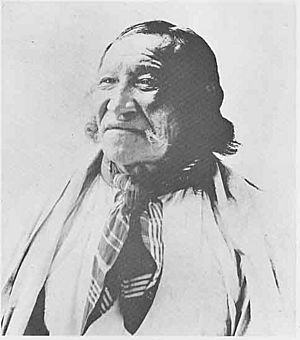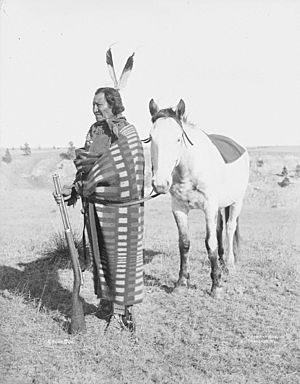Crow Dog facts for kids
Quick facts for kids Chief Crow Dog |
|
|---|---|
| Brulé, Lakota | |
 |
|
| Born | 1833 Horse Stealing Creek, Montana Territory |
| Died | August 1912 (aged 78–79) Rosebud Indian Reservation, South Dakota, United States |
| Spouse | Catches Her Jumping Elk |
Crow Dog (also known as Kȟaŋǧí Šúŋka or Jerome Crow Dog) was an important leader of the Brulé Lakota people. He was born in 1833 in what is now Montana Territory. He lived during a time of big changes for Native American tribes and worked to protect his people's traditions. He passed away in August 1912 on the Rosebud Indian Reservation in South Dakota.
Contents
Family Connections
Crow Dog was related to other important Lakota leaders. His uncle was Chief Conquering Bear, who died in 1854 during an event known as the Grattan massacre. Crow Dog was also the great-grandfather of Leonard Crow Dog (1942–2021). Leonard was known for practicing traditional herbal medicine, leading Sun Dance ceremonies, and helping to keep Lakota traditions alive.
Crow Dog's Life and Leadership
Crow Dog was a traditionalist, meaning he strongly believed in keeping the old ways and customs of his people. He was one of the leaders who helped make the Ghost Dance popular. The Ghost Dance was a spiritual movement that brought hope to many Native American tribes during a difficult time.
In 1890, Crow Dog had a special vision. This vision warned him to tell several dancers to stay away from a large gathering of tribes. Because of his warning, these dancers were saved from being victims of the terrible Wounded Knee Massacre.
Important Court Case
On August 5, 1881, a disagreement between Crow Dog and Chief Spotted Tail led to Spotted Tail's death on the Rosebud Indian Reservation. Crow Dog was later tried and found guilty in a court in Deadwood, South Dakota. He was sentenced to death.
However, lawyers volunteered to help Crow Dog without pay. They filed special legal requests called writs of habeas corpus and certiorari. These requests asked the U.S. Supreme Court to review his case.
In December 1883, the Supreme Court made a very important decision in a case called Ex parte Crow Dog. The court ruled that the local Dakota court did not have the power to try Crow Dog. This was because of the Treaty of Fort Laramie, signed in 1868. This treaty said that the Lakota people had their own laws and courts on their reservation.
The Supreme Court's decision was based on an earlier case from 1832, Worcester v. Georgia. In that case, the court said that Native American tribes had the right to govern themselves. This meant that state governments could not interfere with tribal laws. The ruling in Crow Dog's case was a big victory for Native American tribes. It helped to show that tribes had their own sovereignty, or the right to rule themselves.
Later Years
After the Supreme Court's decision, Crow Dog returned to the Rosebud Indian Reservation. He lived there for the rest of his life, continuing to be a respected member of his community. He passed away in August 1912.
See also
- Leonard Crow Dog
- Ex parte Crow Dog
- In Spanish: Crow Dog para niños



